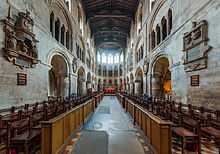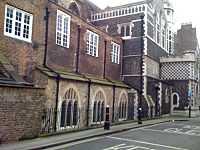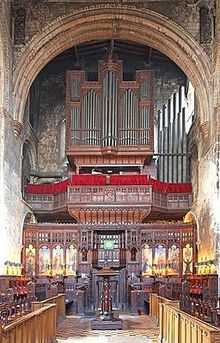St Bartholomew-the-Great
| St Bartholomew the Great | |
|---|---|
|
Priory Church of St Bartholomew the Great | |
|
West door and entrance from Smithfield | |
| Country |
|
| Denomination | Church of England |
| Tradition | Anglo-Catholic |
| Website | greatstbarts.com |
| History | |
| Founder(s) | Rahere |
| Architecture | |
| Style | Norman |
| Administration | |
| Parish | St Bartholomew the Great |
| Diocese | London |
| Province | Canterbury |
| Division |
|
| Clergy | |
| Bishop(s) | Richard Chartres |
| Rector | Martin Dudley |
The Priory Church of St Bartholomew the Great, sometimes abbreviated to Great St Bart's, is an Anglican church in West Smithfield within the City of London. The building was originally founded as an Augustinian priory in 1123 and adjoins St Bartholomew's Hospital of the same foundation.[1]
History

Founded in 1123 by Rahere, a prebendary of St Paul's Cathedral and an Augustinian canon regular, its establishment is recorded as being in gratitude for his recovery from fever. His fabled miraculous return to good health contributed to the priory gaining a reputation for curative powers and with sick people filling its aisles, notably on 24 August (St Bartholomew's Day).

The surviving building originally comprised part of a priory adjoining St Bartholomew's Hospital,[4] but while much of the hospital survived the Dissolution of the Monasteries about half of the priory's church was ransacked before being demolished in 1543.[5] Its nave was pulled down up to the last bay but the crossing and choir survive largely intact from the Norman and later Middle Ages, enabling its continued use as a parish church. Part of the main entrance to the church remains at West Smithfield, nowadays most easily recognisable by its half-timbered Tudor frontage, which was erected by the post-Reformation patron of the advowson,[6] Lord Rich, Lord Chancellor of England (1547-51).[7] From there to its west door, the church path leads along roughly where the south aisle of the nave formerly existed. Very little trace of its monastic buildings now survive, although parts of the cloister now house a café.[8]
St Bartholomew the Great is so named to distinguish it from its neighbouring smaller church of St Bartholomew the Less which was founded at the same time within the precincts of St Bartholomew's Hospital to serve as the hospital's parish church and occasional place of worship. The two parish churches were reunited in 2012 under one benefice.

Having escaped the Great Fire of London of 1666[9] the church fell into disrepair, becoming occupied by squatters in the 18th century. W. G. Grace, however, was one famous congregant before its restoration in the late 19th century,[10] when it was rebuilt under Sir Aston Webb's direction.[11] During Canon Edwin Savage's tenure as rector the church was further restored at the cost of more than £60,000.[12]
The Lady chapel at the east end had been previously used for commercial purposes and it was there that Benjamin Franklin worked for a year as a journeyman printer. The north transept was also formerly used as a blacksmith's forge in order to make ends meet. The Priory Church was one of the few City churches to escape damage during the Second World War and, in 1941, was where the 11th Duke of Devonshire and the Hon Deborah Mitford were married.

The poet and heritage campaigner Sir John Betjeman kept a flat opposite the churchyard on Cloth Fair. Betjeman considered the church to have the finest surviving Norman interior in London.[13]
In 2005 a memorial service was held for Sir William Wallace, on the 700th anniversary of the Scottish hero's execution, organised by the historian David R. Ross.
Charitable distributions in the churchyard on Good Friday continue. A centuries-old tradition established when twenty-one sixpences were placed upon the gravestone of a woman stipulating that the bequest fund an annual distribution to twenty one widows in perpetuity,[14] with freshly-baked hot cross buns nowadays being given not only to widows but others.[15]
The church was designated a Grade I listed building on 4 January 1950.[16] In April 2007 it became the first Anglican parish church to charge an entrance fee to tourists not attending worship.[17]
Oriel window

The oriel window was installed inside St Bartholomew the Great in the early 16th century by Prior William Bolton,[18][19] allegedly so that he could keep an eye on the monks. The symbol in the centre panel is a crossbow "bolt" passing through a "tun" (or barrel), a rebus or pun on the name of the prior.
William Camden wrote:
“It may be doubtful whether Bolton, Prior of St Bartholomew, in Smithfield, was wiser when he invented for his name a bird-bolt through his Tun, or when he built him a house upon Harrow Hill, for fear of an inundation after a great conjunction of planets in the watery triplicity".
Associated organisations
St Bartholomew the Great is the adopted church of various City livery companies hosting services throughout the year: the Worshipful Company of Butchers (one of the seven oldest livery companies), the Worshipful Company of Founders (whose Hall abuts the church), the Worshipful Company of Haberdashers (incorporated 1448 and No. 8 in City precedence), the Worshipful Company of Fletchers, the Worshipful Company of Farriers (incorporated 1674), the Worshipful Company of Farmers (incorporated 1955). The more recently established Worshipful Company of Information Technologists (incorporated 1992), the Worshipful Company of Hackney Carriage Drivers (incorporated 2004) and the Guild of Public Relations Practitioners (incorporated 2000) also have an association with St Bartholomew's.
The church served as the chapel of the Imperial Society of Knights Bachelor before the establishment of the society's permanent chapel in St Paul's Cathedral in 2005.[20]
Film and television
The church was the location of the "fourth wedding" in the film Four Weddings and a Funeral (1994) and of scenes in other films: Robin Hood: Prince of Thieves, Shakespeare in Love, the 1999 film version of Graham Greene's 1951 novel The End of the Affair, Amazing Grace (2006), Elizabeth: The Golden Age (2007), The Other Boleyn Girl (2008) and Sherlock Holmes (2009). It was used by T-Mobile as a stand-in for Westminster Abbey in its "royal wedding" advertisement (2011).
Rectors
- John Deane 1544–1563
- Ralph Watson 1565–1569
- Robert Binks 1570–1579
- James Stancliffe 1580–1581
- John Pratt 1582–1586[21]
- David Dee 1587–1605
- Thomas Westfield 1605–1644 (later Bishop of Bristol)
- John Garrett 1644–1655
- Randolph Harrison 1655–1663
- Anthony Burgess 1663–1709
- John Pountney 1709–1717[22]
- Thomas Spateman 1719–1738 (President of Sion College, later Prebendary of St Paul's)
- Richard Thomas Bateman 1738–1760
- John Moore 1761–1768
- Owen Perrot Edwardes 1768–1814[23]
- John Richards Roberts 1814–1819
- John Abbiss 1819–1883 (elected President of Sion College, 1838)
- William Panckridge 1884–1887[24]
- Sir Borradaile Savory, Bt 1887–1906
- William Fitzgerald Gambier Sandwith 1907–1929[25][26]
- Edwin Sidney Savage 1929–1944
- Newell Eddius Wallbank 1944–1979[27] (Prebendary of St Paul's Cathedral)[28]
- Arthur Brown 1979–1986
- David Lawson 1986-1995
- Martin Dudley 1995–present
Music
Organ

St Bartholomew the Great had an organ installed by John Knopple in 1715. This was superseded by an organ in 1731 from Richard Bridge. In 1886, it was replaced by the organ from St. Stephen Walbrook which was installed by William Hill. Further modifications were made in 1931 by Henry Speechly & Son, in 1957 by N.P. Mander and in 1982–83 by the firm of Peter Wells. Specifications of the church's organ are detailed on the National Pipe Organ Register.[29]
Choirs
Unusually for a parish church, the Priory Church Choir comprises professional singers and is directed by Nigel Short. A choir of amateur singers, the Rahere Singers, sing for some services.[30]
Organists
- Adrian van Helsding 1715–1721
- Isaac Orbell 1721–1731
- Rowland Evans 1731–1739/40
- Richard Ward 1740–1777
- Nicholas Steele 1777–1785
- Thomas Ball 1785–1793
- John Whitaker 1793–1805
- William Bradley 1805–1819
- John Monro 1819–1827
- Miss Wafforne 1827–1834
- Jolly 1834–1836
- Elizabeth Ellen Wafforne/Williams 1836–1849 (became Mrs. Williams in 1843)
- Mary Ann William 1849–1867
- Henry John Gauntlett 1872-1876
- 1876–1885 church was closed
- W. C. Ling 1885–1888
- W.A.B. Russell 1888–1893
- Clifford Parker 1893–1913
- Leonard S. Jefferies 1919-1934[31]
- Nicholas Choveaux 1934–1948
- Paul Steinitz 1949–1961
- Brian Brockless 1961–1971
- Andrew Morris 1971–1979
- Brian Brockless 1979–1995
- David Trendell 1995–2009
- James Sherlock 2009–2012
- Jeffrey Smith 2012–2014
- Ben Giddings 2014–present[32]
Director of music
In 2009 the roles of organist and director of music were divided into two posts.
- Nigel Short 2009–present[33]

Notable burials and monuments
Folklore
The ghost of a monk is reputed to haunt the church in search of a stolen sandal from his tomb.
The church's environs were also the location of many executions, especially during the reign of Mary Tudor. Reportedly during some nights there was a strong scent of burning flesh.
See also
- Sir John Deane's College
- St Bartholomew the Less Church
- List of churches and cathedrals of London
- List of English abbeys, priories and friaries serving as parish churches
References
- ↑ The Old Churches of London, Cobb, G: London, Batsford, 1942.
- ↑ www.british-history.ac.uk
- ↑ www.imagetourist.com
- ↑ London: the City Churches, N. Pevsner and S. Bradley, New Haven, Yale, 1998 ISBN 0-300-09655-0.
- ↑ The records of St Bartholomew's Priory and St Bartholomew the Great, West Smithfield: volume 2, E. A. Webb, 1921.
- ↑ cracroftspeerage.co.uk
- ↑ parliament.uk
- ↑ St Bartholomew's Church website
- ↑ Samuel Pepys-The Shorter Pepys Latham,R(Ed) p. 484: Harmondsworth,1985 ISBN 0-14-009418-0
- ↑ bartsguild.org
- ↑ "The Visitors Guide to the City of London Churches" Tucker, T: London, Friends of the City Churches, 2006 ISBN 0-9553945-0-3
- ↑ The London Encyclopaedia, C. Hibbert, D. Weinreb, J. Keay: London, Pan Macmillan, 1983 (rev 1993,2008) ISBN 978-1-4050-4924-5
- ↑ The City of London Churches Betjeman, J. Andover, Pikin, 1967 ISBN 0-85372-112-2
- ↑ "Present and Past". London: George Bell and Sons. 1876. Retrieved 3 December 2014.
- ↑ "www.spitalfieldslife.com". Spitalfields Life.
- ↑ Historic England. "Details from image database (199817 )". Images of England. accessed 23 January 2009
- ↑ Patrick Sawer (November 18, 2007). "'Four Weddings' church to charge". Daily Telegraph. Retrieved 2014-12-03.
- ↑ Lost City of London website
- ↑ www.oxforddnb.com
- ↑ St Paul's Cathedral website
- ↑ theweald.org
- ↑ british-history.ac.uk
- ↑ thepeerage.com
- ↑ british-history.ac.uk
- ↑ thepeerage.com
- ↑ british-history.ac.uk
- ↑ Phyllis Wallbank MBE, founder of the Gatehouse Learning Centre and wife of Rev Preb Newell Wallbank MusD (qv: www.churchmusicians.org)
- ↑ organ-biography.info
- ↑ "St. Bartholomew the Great, West Smithfield [D03193]". National Pipe Organ Register.
- ↑ "Choral Music at the Priory Church". St Bartholomew the Great.
- ↑ organ-biography.info
- ↑ "Ben Giddens – Organist at the Priory Church". St Bartholomew the Great. 2009. Retrieved 3 December 2014.
- ↑ "Nigel Short appointed Director of Music". St Bartholomew the Great. 2009. Retrieved 3 December 2014.
External links
| Wikimedia Commons has media related to St Bartholomew-the-Great. |
- Official website
- Advowson of St Barts the Great
- Friends of City Churches website
- The Records of the priory and parish church: Two volumes of records, first published by E.A. Webb in 1921. Full-text, as part of British History Online.
- Rahere's Garden: The History & Personalities of St Bartholomew the Great
- Photo essay and history of the priory
- Bell's Cathedrals: The Priory Church of St Bartholomew-the-Great, Smithfield from Project Gutenberg
- 360 Panorama of Lady Chapel, St Bartholomew-the-Great, Smithfield
- 360 Panorama inside St Bartholomew-the-Great, Smithfield
| |||||||||||||||||||||||||||||||||||||
| ||||||||||||||||||||||||||||||||||||||||||||||||||||||||||||||||||||||||||||||||||||||||||||||||||||
Coordinates: 51°31′7.92″N 0°05′58.77″W / 51.5188667°N 0.0996583°W
